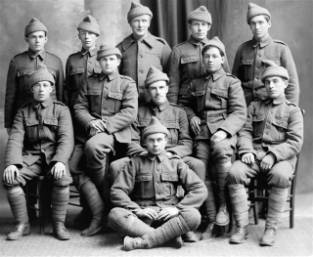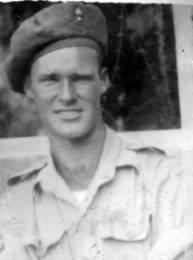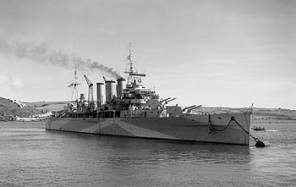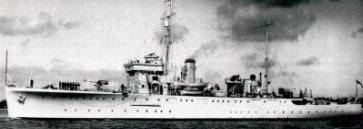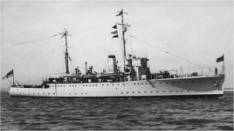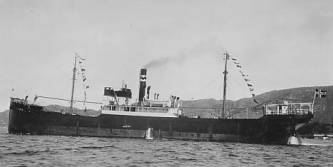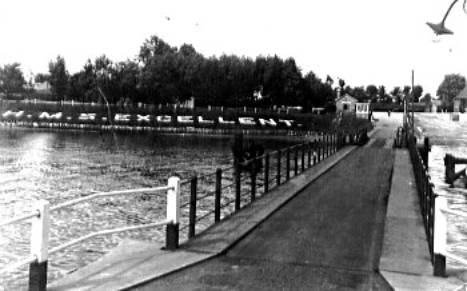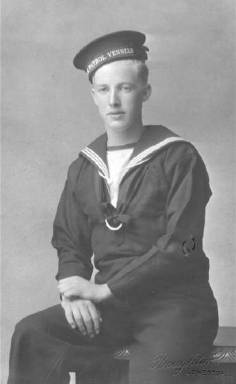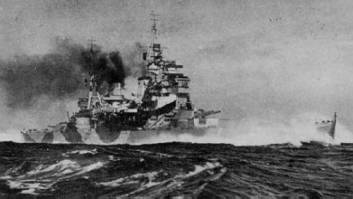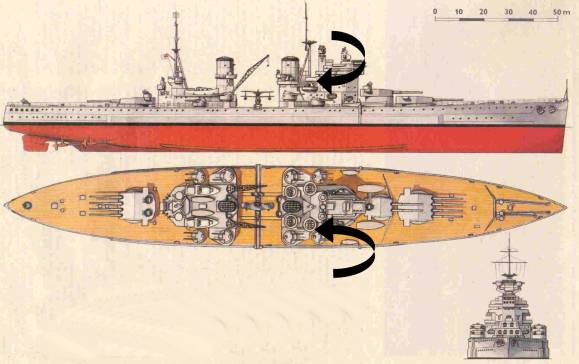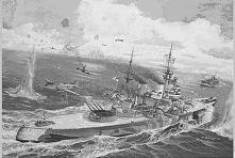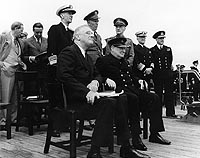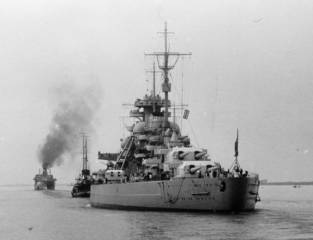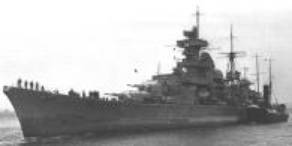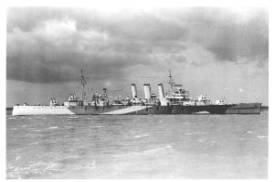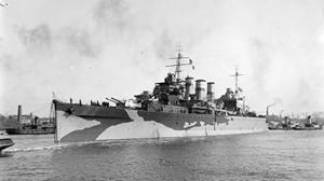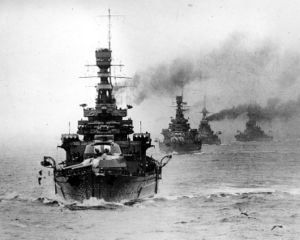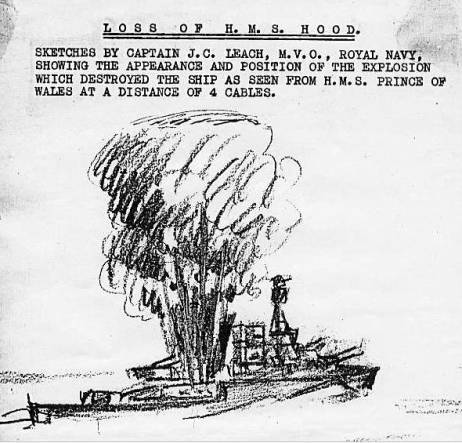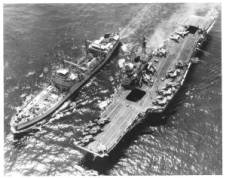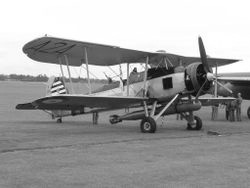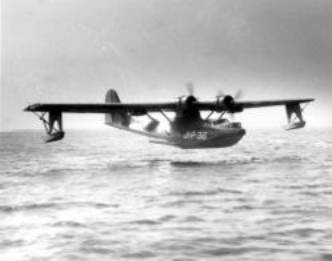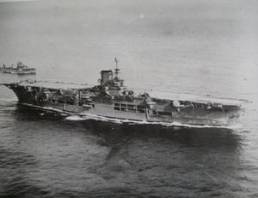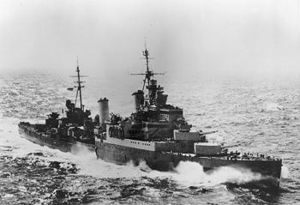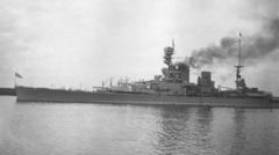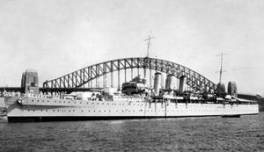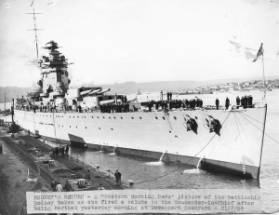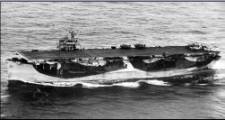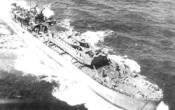Presented by the
Newfoundland's Grand Banks Site
to assist you in researching your Family History
Click on the graphic below to return to the NGB Home Page
To contribute to this site, see above menu item "About".
These transcriptions may contain human errors.
As always, confirm these, as you would any other source material.
|
World War II memoirs of Reginald James Morry Including an eyewitness account of the sinking of the German battleship “Bismarck”. It was Reginald Morry's wish that his memoirs of
this time not be published until after his death. |
I hope that some might find something of interest here and they may feel free
to contact me at the link below if they have any questions
Contributed by Chris Morry
email: cjmorry@ncf.ca
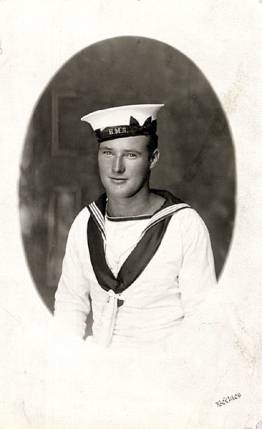
Newfoundland’s Military Legacy
|
Newfoundland participated in both World Wars. Even though the province is small, it produced a famous Regiment of Infantry that fought in Gallipolis and from there to France. They lost quite a few men in Turkey and were decimated twice in France, once in Beaumont Hamel and again at Arras and other areas on the Somme. Total casualties (fatal) were 1305, and at sea 179 lost their lives. Of those that returned, many died of wounds, stress, and worn out hearts. They were given the title “Royal” for their role in the defence of Masnieres (the Battle for Cambrai) by King GeorgeVI, the reigning Monarch of the time. World War II is practically dead history, especially since some anti-Royals disbanded the regiment in 2002, as it's territorial section, according to the present army regime in HQ Ottawa, did not measure up!! During WWII the British changed the regiment over to Artillery so they became known as The Royal Newfoundland Light Artillery to lessen the chances of heavy losses. My brother, William Minty Morry, served in this outfit, my father, Howard Leopold Morry, served in WWI and remained an invalid the rest of his life. |
|
Howard Leopold Morry, back row, centre |
William Minty Morry |
|
During WWII, thousands of Newfoundlanders volunteered for the navy and served on all types of ships. One or two men served on small ships - up to twenty-five men on larger ships. The Royal Newfoundland Regiment was active as well as a Royal Air Force group.
Basic Training Cut Short by the Declaration of War
I joined the Royal Navy two weeks after my eighteenth birthday (DOB 03 August, 1921). Myself and twenty-four other Newfoundlanders became temporary additional crewmembers on “Berwick”[i], visiting St. Johns, Newfoundland at that time. We did our basic training while the ship carried out courtesy visits to Atlantic ports in Canada and the USA.
HMS “Berwick”
Regarding my training on board HMS "Berwick", it was interesting, but as far as action was concerned it was quiet. She was known as a county class cruiser, Britain had quite a few of this class of ship which served her well, armoured with 8" diameter guns and secondary armaments - 4" diameter guns. Some of these cruisers became very famous. Three of these cruisers took on the "Graf Spree" at Rives La Platte, where she was scuttled. "Berwick" lasted out the war and was sent to the Breakers Yard July 13, 1948. Just before the war started we visited some USA ports to show the Flag. One nice city was Bar Harbour, Maine. A beautiful place - some of the USA Atlantic Fleet were at anchor there. We were granted shore leave. One point of interest - we were informed that the writer Zane Grey had his sports sword fishing boat tied up at the wharf, so some of us walked along the harbour front to see it. Our stay only lasted a few hours as suddenly all leave was cancelled, and the "Berwick" weighed anchor and left port without delay. A few hours after leaving port, WWII was declared.
Preparations for War
The ship immediately was put into a war type mode. All projectiles were taken from the magazines; practise fuses were replaced with live fuses. For a day or so, the ship was a beehive of industry, as the ship was made ready for action. The ship's company was split into two watches, usually titled Port and Starboard. Each watch contained sufficient key staff to man the guns and controls to enable the ship to defend herself at a moments notice. On action alarms being sounded the "off watch" would take up their positions with the least possible delay. Usually the defence of the ship would have its full compliment and be at the peak of efficiency and ready to give battle in a few minutes. The off duty watch still had duties; to maintain the ship, clean the ship, and countless other details, including rest periods, sleep time and self-maintenance. This system was tough on the men, both at sea and in harbour (air attacks). Unbroken sleep was difficult to achieve and long voyages were very trying and wearying on the crews. Gone were the peace time days with ample time for rest and relaxation - never to return during wartime. Even after sixty-five years I find it easy to remember the names of our first Royal Navy instructors. We had two; our chief instructor was Petty Officer Bowden and his back up was leading seaman, Jacobs. Both were gentlemanly and kind. Jacobs was unforgettable. He wore a full black beard and his rather prominent nose was displaced and ended up obliquely across his face. He said it was the price he paid for defending his title of West Indian Fleet Boxing Champion. At that particular period, Britain possessed a very large navy and it was unfortunate that I never had the pleasure of meeting these instructors again in my six and half years of service. Some weeks later, we got caught in a hurricane whilst on patrol in the Caribbean Sea. We could not out-run it or take evasive action as hurricane spotting and warnings did not exist at that time. However, ship's instruments gave the navigator a warning of heavy weather. The ship had a very experienced bridge staff so the ship ploughed right through the storm and we even enjoyed a few minutes respite as we crossed the eye of the hurricane and then back into the maelstrom to break out the other side. I was amazed at the size of the waves and the fury of the wind. I never worried, as I had so much faith in the Royal Navy that a mere hurricane couldn't sink a ship like "Berwick". I was messenger on the bridge that night and really enjoyed the experience. The ship received heavy battering and suffered damage to the upper deck with the air intakes being swept away and many other damages of a serious nature. Below decks, the ship was in shambles with some crewmembers suffering various broken bones. The Admiral found it necessary to put into dry dock in Bermuda to repair the damage.
Service in the West Indies
Even though winter was upon us, we Newfoundlanders from the bleak north revelled in the balmy sunshine and spent a lot of free time swimming, sailing, visiting other Bermuda islands, and of course, Hamilton, which was teeming with USA tourists. On arrival at Bermuda, the West Indies Fleet Headquarters,
we Newfoundlanders were split into three groups, ten assigned to “Dundee” [ii][myself included], ten to “Penzance”.
The balance remained on “Berwick”. “Dundee” and “Penzance”[iii] were escort ships, fitted out for convoy
work and at that time they were carrying out blockades on the Dutch West Indies
ports, as many German oil tankers were trapped in port due to the unexpected declaration of war in
September 1939. Fate took a hand in my assignment to “Dundee” and not “Penzance”.
Almost a year later “Penzance” was to be dispatched, in August 1940, to escort
a convoy from Canada to the UK. She was torpedoed |
|
HMS “Dundee” |
HMS “Penzance” |
|
We took passage from Bermuda on a small cargo ship named "Assyrian Prince" we were billeted on the main hatch cover and enjoyed a quiet trip to Port of Spain, Trinidad. Both ships were built for the China stations as river patrol vessels, recently returned and immediately put in service as patrol and escort ships armed with two 4" diameter guns, one fore and one aft, two depth charge throwers and depth charge rails on the quarter deck. On our arrival at Trinidad, "Dundee" was at dockside so the ten of us were marched on board and were assigned our action stations, watch, locker and mess number. We unpacked and stowed our gear, and familiarized ourselves with the ship's layout. We were informed that both ships were carrying out a blockade on the islands Aruba, Bonaire, and the capital island Curacao (Dutch Antilles). These islands were still enjoying a troubled peace. Many German oil tankers were caught in port by the sudden declaration of war. Their only reason for staying in these ports was our blockade, and given the opportunity, they would have headed straight for a German port. It was a tedious job. We would spend two weeks patrolling in the boiling sun and at night watch the shore lights for ships trying to sneak out. Then happy days, "Penzance" would arrive on the scene and we would depart to refuel, fill water tanks, and re-provision. After a few hours shore leave, we would carry out random patrols for subs and German ships along the coast of South America and end up in time to relieve "Penzance" at Curacao. This routine ended abruptly when we received orders to proceed post hast to the scene of the Battle of the Pocket Battleship "Graf Spee". Three British cruisers (HMS “Exeter”, the flagship for the South Atlantic; HMS “Ajax”; and HMS “Achilles”) had this German battleship bottled up in Rio de la Plata. She came under international rules and enjoyed three days of grace before she had to put to sea. That the cruisers were able to drive this superior ship into port was a terrific victory. The fact that the captain chose to scuttle the ship rather than come out fighting was Germany's first defeat at sea. "Graf Spee" was an active raider and had sunk quite a few merchant ships in the South Atlantic. After sinking the "Graf Spee" the three cruisers returned to Britain for extensive repairs and replacement of crewmembers that had been killed or wounded. Of course, upon our return to Trinidad, the German tankers had flown the coop
North Atlantic Convoy Detail - The Sinking of the “Dundee”
In September 1940 our orders arrived. We were to pick up a convoy "SC3" at Sydney, Nova Scotia and escort it to Britain. It being a slow convoy, six to nine knots, we knew from the start that it would be a long and hazardous voyage. Our top speed for short durations was sixteen knots. Our captain visited HQ at Sydney. The convoy was assembled and from the word go it was trouble, with old ships slow, and subject to breakdowns. The larger ships were forced to wait for the slower ones and rounding up strays was continuous. After about a week we had to exercise caution to conserve fuel and stick with ASDIC sweeps for enemy subs. I feel we were subjected to enemy surveillance from week one. It seemed that every time I went to shower the action alarm would go and I would end up on the after four gun with only a towel around my waist. I can't recall when we lost the first ship, as the bridge staff were the only ones familiar with the count. We had a total of forty ships assembled at Sydney. To this day I do not know how many of the convoy survived. Travelling the ocean at 120 miles per day makes one realize how large the North Atlantic is. Spending countless days patrolling around and through the lanes of the
convoy and sometimes
dropping depth charges on ASDIC signals of a hazardous nature was tiresome
and constant. At 11:30 pm, The stern of the ship was gone, along with the officer's quarters, including personnel, the depth charge crew, and the after gun crew. I believe we lost about forty people but I am not sure of that number as losses were seldom posted. After the captain received the damage control report, he gave the order to abandon ship. I made my way to my station and boarded the skiff full of survivors. As we lay alongside before departure, I knew we would sink. Seated forward, with my feet on the boat's bottom planks, I could feel cold water creeping up my legs. On the rower's second stroke the skiff swamped and then it was swim or drown. Being a weak swimmer, I was soon on my own and began looking for the light from the pickup ship. After swimming for some minutes, whilst on top of a wave, I saw the light at waterline so I changed direction, but every time I spotted the light it had changed direction. Off to my left I could hear a Newfie friend of mine singing "Roll Out the Barrel". He was on a Carley raft. I heard nothing else of them after a while. But as it turned out, all my Newfoundland shipmates were rescued. I did not hear the explosions when five or six merchant ships went to the bottom, or see the flames from burning ships. I was still paddling towards the light. I found a great comfort in having my inflatable lifesaver snugly tied around my waist. I decided to swim along at my own speed and as the pickup ship was going in circles I felt sure it would close in on me. Some time after making this decision I suddenly found myself hanging grimly on the bottom step of a "Jacob's Ladder". Every time the ship rolled I would find myself swinging in the air and as she rolled back I would be doused under the surface. Just to my left, at a distance of twenty feet was the tip of the propeller blade, turning very slowly, resulting in me increasing my grip on the swinging ladder. After making some progress ascending the ladder, I was suddenly grasped by a large hand and bodily lifted over the ship's rail and dumped unceremoniously upon the steel deck. Please note this life saving strategy of picking up survivors was discontinued when "Wolf Pack U Boats" attacks became a reality. Then, it was save the ships, so keep steaming in formation. I was picked out of the ocean by a Norwegian timber ship[iv]. Our pickup ship was carrying a very light load, which left the tip of propeller above the water and the light load accounted for her extreme roll. I am most thankful to the brave members of this Norwegian ship and their willingness to risk their lives to save ours.
The Norwegian Timber Ship D/S “Vigsnes”
I eventually was directed to a cabin filled with merchant ship survivors as well as some of the crew of "Dundee". They were discussing the action and I gathered five or six merchant ships were sunk immediately after "Dundee" was hit and put out of action. U- boat 48 surfaced and simply picked off the ships she had chosen, the last ship she sunk was by gunfire, which indicates that she was out of torpedoes or else conserving what she had left on board. U-48 made her escape shortly before the arrival of the relief escort ships from Britain. Apparently, I missed all this action whilst concentrating on the light. Many merchant sailors were dead when picked up, many perished in oil fires and oily scum. Munitions ships went up in what would seem one giant explosion. U-Boat 48 was active all during the war years, and was scuttled when she was ordered to place herself into the hands of the allies in 1945.
Reassignment to HMS “KG5”
We landed in Northern Ireland without incident and were kitted, and I was sent on a week leave and from there to the gunnery training school HMS "Excellent" at Portsmouth for training as an anti-aircraft gunner (AA3).
Entrance to HMS Excellent c1940 I was drafted from HMS "Victory" barracks to HMS "KG5"[v] in Scapa Flow as an able seaman, third class anti-aircraft gunner in December 1940. Arriving on board, I found twenty-four Newfoundlanders had joined the ship prior to my arrival. One of them was a cousin , Will Morry, that I knew very well.
Will Morry I became part of a two-pounder multi barrel automatic firing gun called Pom Pom; located high on the super structure that surrounded the lower half of funnel number one, starboard side. This became my second home for the following nineteen months, working four hours on watch and four hours on other duties and rest periods.
HMS “King George 5” The ship commonly referred to, as "KG5" was Britain's latest battle ship, small as compared to other Royal Navy and foreign battleships. She was lithe, lively, and fast with armament number ten 14" guns in three turrets, two turrets forward of the bridge turret "A" - four guns, "B" with two guns and "Y", with four guns located on the quarter deck. Secondary armament number eight – 5.25" diameter dual-purpose surface and air guns located in four turrets, two starboard side, two port side, in the waist of the ship.
Location of R. Morry’s Pom Pom emplacement (Source: www.mo-na-ko.net/lode-monografie.htm) Both types of the guns were new to the navy, tried and proven to be accurate with good range and rapid firing capabilities. "KG5", unlike the unfortunate "HMS Hood" (no armour on the main deck), was designed to carry a main deck of 3" armour and a band of 10" thick armour bolted on the side covering the critical areas of the ship. She and her sister ship (HMS “Prince of Wales”)under construction were to be our main defence against the modem German navy. Of note to Newfoundlanders, it was on board the “Prince of Wales” that the Atlantic Charter was later signed by Roosevelt and Churchill in Placentia Bay, August 10-12, 1941. |
|
HMS “Prince of Wales”
|
Roosevelt and Churchill on “Prince of Wales” in Placentia Bay, Newfoundland |
|
Our close range anti-aircraft guns were located in strategic positions on the various super structures about six or seven mounts each, with a crew of eight men. The German battleship "Bismarck"[vi] and sister ship (“Tirpitz”) were heavy cruisers and were our enemies, and no doubts existed onboard "KG5" that every man had to be efficient at his job. Teamwork was essential and repetition was the name of the game. Day by day, in harbour or on patrol, day or night, training was conducted in all situations and conditions.
The Battleship “Bismarck” During the last months of 1940 to early 1941 merchant fleets were being decimated. In April 1941, 700,000 tons of merchant and navy ships were sunk. Hitler decided that the time had arrived to dispatch his elite ships to prey on North Atlantic shipping to shut down critical supplies to the UK. "KG5" was flagship of the home fleet under the command of Admiral Tovey and Captain Tennant, two very able senior officers. Atlantic shipping was their responsibility. Early May we were prepared and resigned to the fact that we would meet "Bismarck", as she had to be stopped. Surface raiders loose in the Atlantic would spell disaster to the UK lifeline of supplies. One of Germany's capital ships could sink an entire convoy in minutes. On May 22, Suddenly, the "Prince of Wales", "Hood", with two cruiser and destroyer escorts weighed anchor and left the harbour. The rumour was that "Bismarck" and "Printz Eugen"[vii] had left the Polish port of Gydivia and were making their way up the Norwegian coast, "Bismarck" anchored in Bergen May 21 and was reported on May 22 still heading north along the Norwegian coast. Meanwhile, on the lower decks, we knew that this was the beginning of a chase and possibly the big battle. We had to have patience and wait till we put to sea before we would be officially informed.
German Battleship “Prinz Eugen”
The Admiral's strategy was based on his assumption that "Bismarck" was headed for the Atlantic and would proceed around northern Iceland, then proceed south via the Denmark Strait, even though it was mined by the Royal Navy, and the Channel was restricted with ice, He dispatched two cruisers, "Norfolk"[viii] and "Suffolk"[ix], to take up surveillance on the southern end of the strait. |
|
HMS “Norfolk” County Class Cruiser |
HMS “Suffolk” Kent Class Cruiser |
|
"Prince of Wales" and "Hood" were to lay in wait south of Iceland and under no circumstances attack, but to wait for "KG5", "Repulse"[x] and "Victorious" to join them. "KG5" and company left Scapa Flow on May 22 and headed into the Atlantic on a north-westerly course. Meanwhile, crews of all ships were brought up to date on developments. On the morning of May 23 "Norfolk" and "Suffolk" sighted two ships steaming south in the Denmark Strait, "Bismarck" caught a glimpse of "Norfolk" and opened fire. "Norfolk" managed to hide in the fog. They both continued to shadow the enemy by means of radar.
HMS “Repulse”
On receiving news of the fighting, "Prince of Wales" and "Hood" begged the Admiral through the night of May 23 for permission to attack. At first the answer was "No". Finally the Admiral relented and warned them that they could carry out an attack but they were to break off the action if they lost control, as he didn't want the ships endangered. At 5:30 am they opened fire on the "Bismarck" and "Printz Eugen". At about 6 am a shell from a 15" gun hit "Hood" amidships and penetrated deep into the hull, exploding, and in an instant the mighty "Hood" was gone. The "Hood" was built prior to the Battle of Jutland in World War I and her decks were not armoured, consequently the projectile at the end of its trajectory went down through the many decks into a magazine and exploded, leaving only three survivors.
Source: Proceedings of 2nd Board of Enquiry into the loss of HMS Hood, 1941
"Prince of Wales" got one hit on the "Bismarck" before she withdrew with her bridge demolished and the bridge crew killed or wounded. "Printz Eugen" also suffered damages. "Prince of Wales" had taken hits from "Printz Eugen" as well as and four from the "Bismarck". The bridge staff were wiped out, so she made smoke and broke off the action. Some of the projectiles that hit the "Prince of Wales" did not explode and lodged in her bilges and were removed in Liverpool dockyard. The action lasted about 20 minutes, more or less. On May 24, the "Victorious"[xi] managed to get within a hundred mile range of "Bismarck" and launched an air attack with Swordfish aircraft carrying torpedoes. The machines attacked and returned, which was a miracle When the battle results were accumulated after the sinking of "Bismarck", a survivor indicated that both German ships suffered damage; "Bismarck" in the bow, with a hole in one of her oil tanks; "Printz Eugen" losing fuel. Damage can be credited to both aircraft and battleships. |
|
HMS “Victorious” (Right) |
Fairey Swordfish |
|
After the air strike on May 25, her Admiral on "Bismarck" dispatched the "Prinz Eugen" for home. A decision was made that the cruise must be cancelled. "Bismarck" took evasive action and drastic course alterations dining the night, which resulted in British fleets loosing contact. During May 26 the Royal Navy was in a worried state as the chase was moving in the general direction of Brest and if "Bismarck" reached that port, the game would be over, as Brest was so heavily guarded that even air attacks from Britain would be costly and chances of success low. The loss of the "Hood" was a shock to the Navy and the older Navy members couldn't believe that the "Hood" could be wiped from the face of the earth in a matter of seconds. Feelings of despair turned to anger and the search was intensified. The battleship "Repulse" was detached from the fleet and returned to Britain for refuelling. The battleship "Rodney" replaced her at 10:30 am. May 26. A Catalina flying boat, coastal command based Northern Ireland, was on patrol and was lucky, flying directly over the "Bismarck" and spotting her through a hole in the clouds. On going down to investigate, she was met with a hail of fire, so she turned tail and got out of range and immediately transmitted "Bismarck's" position. As presumed, "Bismarck" was headed for Brest and was within 1,000 miles of that port.
PBY Catalina “Flying Boat”
As most of the fleet had been steaming at high speed since May 21, shortage of fuel was so critical that all the destroyers were dispatched to Iceland for refuelling. The capital ships were now under the protection of the Swordfish planes as far as the submarine protection was concerned. The flagship "KG5" was also working on depleted fuel tanks but was just hanging on. On receiving the position of "Bismarck", all ships made a course alteration to intercept her. The situation was bleak. Unless "Bismarck" could be slowed down, the home fleet didn't stand a chance of intercepting her, as she had a lead of 150 miles and once inside aircraft range of Brest all would be lost. As a precautionary measure "Ark Royal"[xii], "Renown"[xiii], "Sheffield"[xiv], "Dorsetshire"[xv] and destroyer escorts had been dispatched from Gibraltar. On assessing the situation Admiral Tovey figured that "Ark Royal" had the only chance of delaying the "Bismarck". So they were instructed to proceed with all speed and when in range to set up a series of torpedo attacks by Swordfish aircraft. At about 6:00 pm the "Ark Royal" launched the first attack, but unfortunately it was on the wrong target. "Sheffield" happened to be in the wrong place at the wrong time. Due to the able handling of the ship at full speed managed to evade 8 or 9 torpedoes. The second attack was launched at 7:10 pm, as soon as the planes could be refuelled and reloaded with torpedoes. The weather was bad, poor visibility and rough seas still existed. |
|
HMS “Ark Royal” |
HMS “Sheffield” |
|
HMS “Renown” |
HMS “Dorsetshire” |
| The second flight reported
"no hits" but shortly after this report "Sheffield"
reported by radar observations that "Bismarck" for no logical
reason, altered course, and it was soon discovered that she was moving in circles. Apparently she had
received one hit on the stem, jamming one rudder fore and aft,
and her second rudder was jammed 15 degrees to port. All through that
night, the "Ark Royal" made various torpedo attacks.
No hits were recorded and no destroyers sunk, but the near misses on these
destroyers were uncountable. As they moved in at full speed to attack,
the curtains of water set up by salvos of large shells hid the ships.
The same thing happened on returning from each run. Meanwhile, Admiral
Tovey and staff were busy working out strategies for an early morning
attack on "Bismarck". Especially since the second attack by
"Ark Royal's" aircraft had
slowed the enemy's speed down sufficiently to enable the home fleet to
intercept her. "Sheffield", still shadowing "Bismarck"
by radar, had confirmed that "Bismarck's" speed and manoeuvrability
were still affected.
I have mentioned radar several times in this story, but never mentioned its importance. During the years 1939 to 1941 great scientific work had been done into advancing this technology. Modifications on changes to design etc, were fruitful and sufficient enough to enable "KG5" to change from the old ranger finder and log calculators to "radar" control. We achieved great improvements on accuracy and speed that enabled us to get on target rapidly. Our five gun salvos, on arrival, were in tight groups - very destructive when on target. Of course German ships were accurate even on first salvos, so surprise was a good strategy. Germany also had radar, but not as advanced as the latest British radar. At this stage of the chase, our battle ships were short of fuel oil. "Repulse", low on fuel, departed for the UK. Luckily "Rodney"[xvi] was intercepted and joined our force, a welcome sight with her 16" diameter guns. Her decks littered with packing cases containing spare parts, she was on her way to a USA dockyard for a major refit but in spite of this, she was deadly.
Nelson Class battleship HMS “Rodney”
During the first watch, 8 am to 12:00 pm, all members were instructed to go below in relays to change and shower; a procedure carried out when action is imminent. The men were to return immediately and resume action stations. During the night of May 26, quiet discussions were ongoing among some of our crew concerning the "Bismarck". She was 823 feet long, with a beam of 118 feet and 50,000 tons. Fully armoured deck and ship's sides fitted with a band of 11" thick armour protecting magazines, engine rooms, and other vitals. She carried 15" diameter main guns in four turrets, two forward of the bridge and two on the quarterdeck. Her secondary armaments were six twin gun turrets, three in the waist, port and starboard, 4.7 dual purpose. It was obvious at this time that the enemy ship was injured, so plans were put in place to attack early morning. "KG5" and "Rodney" would approach in line abreast from the west, which would silhouette "Bismarck" against the brightening easterly sky. May 27 at 8:43 am (double summer time) "Bismarck" was spotted at 12.5 miles. She was still not visible to the naked eye. She had some control, as she started to alter course to bring her guns to bear on seeing our approach. About four minutes later "KG5" opened fire. We could see the fall of shot from our position, as great clumps of white water rose all around "Bismarck" – much higher than her mast and tower. Then we saw a ripple of fire from "Bismarck" as we waited for the scream of 16" projectiles. Suddenly, the stern of the "Rodney" was lifted out of the water and you could see her propeller turning for split second, a near miss. Both British ships continued firing at 9:00 am. Two hits were positive, one on the foc'sle and one at the base of "Bismarck's" superstructure. At 10 nautical miles the "Norfolk" and "Suffolk" opened up with their 8" diameter guns. Now she was slammed with salvos of 16", 14", 8", and 5.25" diameter projectiles. "Bismarck" was still firing and suddenly changed targets and we began to feel and hear screaming shells close overhead. As we were in exposed positions, we had orders to leave our gun position and go below. Whilst below we were given a running commentary and after a brief period of twenty minutes or less, we were ordered to stand to on our Pom Pom guns. "Bismarck" was being constantly hit. However, she was giving a good account of herself as we could hear the thud of shells falling around our ship. On gaining our gun position once more, we were now about 4 miles from the "Bismarck" and still in a rapid-fire mode. "KG5" and "Rodney" were angling to and away from "Bismarck". "KG5" was delivering five gun salvos right on target. Every salvo caused terrific destruction to the enemy ship. Pieces of metal were flying in the air like paper. Her super structure was being dismantled with demonic and unimaginable force. Some of her guns went on firing in an inaccurate manner, her turret guns were drooping over the side, some had barrels blasted off. One gun located in "A" turret was pointing up in the air at above maximum elevation. A salvo across the bow blasted her anchor cables loose, and they momentarily stood up straight, almost vertical. The quarterdeck turrets suddenly were evacuated and the next salvo she received swept the quarterdeck clean, not a man could be seen. She was on fire now from stem to stern; flames could be seen from the apertures in the deck when deck structures were blasted off. Her upper deck was in shambles. The only structures that remained were the base of the bridge and the base of a structure forward of the quarterdeck turrets. She was now listing to port and down by the stern. We were all realizing that this was the end of a truly majestic ship. I wasn't very sympathetic however, realizing that she had the power to destroy in seconds any ship she might meet. If she had room to roam the ocean, it would have been tragic. I admired the crew of one small gun located on the port waist deck, which kept firing after all her main armaments had ceased. This little gun would fire and you could see a small projectile skipping across the sea to sink a half-mile from our ship. The binoculars assigned to the gun crew were much in demand. By this time "Bismarck" was a total wreck. The order to cease firing was given; all was quiet. The "Dorsetshire "was ordered in to finish "Bismarck" off. She sent two torpedoes into the starboard side and then came around and delivered the last torpedo on the port quarter. Then one of our destroyers sighted grey smoke on the surface some miles distant, which could have been a discharge from a submarine, so the fleet picked up stations and we were ordered to head north. "Dorsetshire", busy picking up survivors, on getting the order to take up her position in the fleet, having picked up only 85 men, had no alternative but to join the fleet, dragging men along until they let go of the boarding ladders. Some say that there were eight hundred in the water but the believable number would be 200 to 300. The Destroyer "Maoira" picked up 25 men, bringing the total survivors up to 110 from a crew of 2000 plus. As we left the scene, Admiral Tovey gave us a running commentary on the last few minutes of "Bismarck's" life. To quote Admiral Tovey, "She is now laying over to port, her funnel stub level with the surface, she is now rolling over as I can see her keel. Her stern has now sunk below the surface and the last sight was her bow disappearing beneath the waves." At about 10:15 am the battle ceased. The voyage back to Scapa Flow was uneventful except crossing the north end of Scotland. Heavy concentrations of aircraft could be heard overhead. Not wanting a night battle with aircraft, the fleet shut down all engines and machinery and we drifted in total darkness and silence until the overhead activity ceased. Then we proceeded to safe anchorage inside the boom defence at Scapa Flow. We presumed the activity overhead was the German air force that Hitler promised would destroy us. I've listened to oceanography reports from USA and German specialists who state that the "Bismarck" couldn't be sunk and that they carried out a "coup de grace" and scuttled her. I know what I saw. She was completely destroyed by gunfire. The last report I viewed on TV assured me that the talk of no holes in the armour was proof to them that she was scuttled. These so called specialists did not have any knowledge on why capital ships were encumbered with thousands of tons of armour. Up to the end of World War II, there wasn't a projectile designed that could bore a hole through armour plate. The last pictures by some British firm of oceanographers who guided a robot camera under the quarterdeck showed a very large hole in the hull port quarter, below the armour belt. As she was listing to port down by the stern before being torpedoed by "Dorsetshire" it would be difficult to state whether it was the result of gun fire or the torpedo or both. 1 wish to state that this report is based on what I observed during the battle. I was a lower deck Able Seaman with less than two years experience in naval war at that particular time. If I am in error, or my statements are inaccurate, I stand corrected. ConclusionI arrived on board "King George the fifth" the twelfth month of 1940 and served on her until she was decommissioned shortly after the sinking of "Bismarck". I went on to serve on the HMS "Striker"[xvii] aircraft carrier, HMS "Bahamas"[xviii], an escort frigate, and finally on LST 214[xix], supplying Canadian forces in Europe. Between ship changes, I returned to HMS "Excellent" for further training in gunnery on two further occasions. I was never drafted to ships at foreign stations, and spent all my years in the North Atlantic on Russian convoys and North Atlantic patrols. The last year of my service I was involved in returning Lease-Lend landing ships to Norfolk, Virginia USA. |
|
HMS “Striker” |
Tacoma Class Patrol Frigate Similar to HMS “Bahamas” |
“LST 214” |
|
I have some doubts regarding the identity of our convoy, as the information was hush-hush and all the surviving crewmembers were drafted to various ships on returning to Depot. The date of "Dundee's" sinking was September 15, 1940, location about 200 nautical miles south of Iceland. During my service I never met any of my "Dundee" shipmates until many years after my Royal Navy service ended.
AppendixRoyal Navy ships involved in the chase of "Bismarck" and "Printz Eugen" Home Fleet HMS King George V [Battleship] HMS Prince of Wales, sister ship [Battleship] HMS Repulse [Battleship] HMS Hood [Battleship] HMS Rodney [Battleship] HMS Victorious [Aircraft Carrier] HMS Norfolk [Cruiser] HMS Suffolk [Cruiser] HMS Excellent [Gunnery Traing School] HMS Victory [Portsmouth Division Headquarters]
Gibraltar Station HMS Renown [Battleship] HMS Ark Royal [Aircraft Carrier] HMS Sheffield [Cruiser] HMS Dorsetshire [Cruiser] [i] HMS “Berwick” (65) From Wikipedia, the free encyclopaedia HMS “Berwick” (65) was a Royal Navy Kent class - one of the subclasses of the County class heavy cruisers. She was built by Fairfield Shipbuilding & Engineering Co. (Govan, Scotland), with the keel being laid down on 15 September 1924. She was launched on 30 March 1926, and commissioned 12 July 1927. History When completed “Berwick” was sent to the China Station, where she remained until a temporary detachment to the Mediterranean in 1936. After reconstruction between 1937 and 1938, she served on the America and West Indies Station with the 8th Cruiser Squadron until 1939. When World War II started, she served on ocean convoy escort duties, then formed part of Force "F" (with “York”) when hunting groups were formed to find the German raiders. She did not make contact with any raider, but intercepted the mercantile blockade runners “Wolfsburg” and “Uruguay” in the Denmark Straits during March 1940. On 9 April 1940 she participated in the Norwegian campaign and on 10 May 1940 in the Invasion of Iceland. She was then allocated to Force "H" at Gibraltar arriving on 7 November. On 11 November 1940, “Berwick” escorted the carrier “Illustrious” in the successful raid against the Italian battle fleet in Taranto harbour. Later that month she also escorted convoys between Egypt and Greece. On 24 November 1940 Berwick had received orders to go to Freetown, escorting carrier ‘Formidable” with sistership “Norfolk” where they would form into Force "K" to hunt for the German heavy cruiser “Admiral Scheer”, but on 27 November those orders were amended to allocate her to convoy escorts in the North Atlantic. While on passage to Gibraltar, an Italian Squadron comprising the battleships “Vittorio Veneto” and “Andrea Doria” attempted engaging the British, resulting in the Battle of Capo Teulada. In the course of the ballistic contact, at 1222 hrs “Berwick” sustained a 203 mm (8") hit on "X" turret, with 7 dead and 9 wounded, and another at 1235 hrs, probably another 203 mm, which exploded in the Officer's quarters. On 25 December 1940, Berwick came under attack from the German heavy cruiser “Admiral Hipper” off the Canaries when she formed part of the escort to convoy WS-5A, a troop convoy to the Middle East. “Berwick” engaged the attacker but got the worst of the encounter, sustaining a fair amount of damage. She had to return to Britain for repairs, which lasted until June 1941. When repaired “Berwick” joined the Home Fleet and for the remainder of her wartime career she was escorting convoys to North Russia and operating in the northern North Sea. In February 1942 she was escorting the carriers which attacked the German battleship “Tirpitz” in her anchorage at Altenfjord. She escorted two more carrier against the Tirpitz in 1944 and again in 1945. Berwick's last role was to escort carriers that were raiding the Norwegian coast in 1945 After the war she was allocated to BISCO for scrapping on 15 June 1948 and arrived at Hughes Bolkow, Blyth, on 12 July for breaking up.
[ii] HMS “Dundee” (L84) From Wikipedia, the free encyclopaedia HMS “Dundee” (L84) was a Royal Navy sloop of World War II Some sources put “Dundee” with the Falmouth class sloops, others that she was of the Shoreham class sloops which was derived from the Bridgewater class sloop, others that she was of the Bridgewater class. She was built in Chatham Dockyard in Kent and launched in 1932. HMS “Dundee” served as an escort for convoys during the Battle of the Atlantic. She was sunk at 00.25 hours on 15 September 1940 by the most successful German submarine of the war, U-48, commanded at that time by Captain-Lieutenant Bleichrodt. U-48 attacked a convoy, SC-3, of which HMS “Dundee” was the only escort. U-48 missed the British merchant ship Empire Soldier, but later, U-48 torpedoed and sank “Dundee”, commanded by Capt. O.M.F. Stokes, RN, in position 56º45'N, 14º14'W, off Northern Ireland. The Imperial War Museum has a recording from its sound archives of W J H Mills, a Canadian serving with the Royal Navy on HMS “Dundee”, describing the sinking. In the recording he recounts "The blast was so severe that it tore the lockers away from the bulkhead mess – we knew we’d been hit – there was no mistaking it."
[iii] Name: HMS “Penzance” (L 28) Type: Sloop (Folkestone) Tonnage: 1.025 tons Completed: 1931 - Devonport Dockyard, Plymouth Owner: The Admiralty Date of attack: 24 Aug, 1940 Nationality: British Fate: Sunk by U-37 (Victor Oehrn) Position: 56.16N, 27.19W - Grid AK 6333 Complement: 97 officers and men (90 dead and 7 survivors). Convoy: SC-1 Route: Sydney - UK Notes on loss: At 20.38 hours on 24 Aug, 1940, the HMS “Penzance” (L 28) (Cdr Allan John Wavish), escorting the convoy SC-1, was hit by one torpedo from U-37 and sank in a few minutes southwest of Iceland. When the depth charges of the sinking sloop exploded the U-boat was slightly damaged by the detonations. Seven survivors were picked up by a merchant from the convoy, the “Blairmore”, but she was also sunk by U-37 during the night. The survivors were rescued by the Swedish merchant “Eknaren” (Master Erik Kallstrom) and landed at Baltimore. Source: http://uboat.net/allies/merchants/ship.html?shipID=474
[iv] D/S “Vigsnes” At the beginning of Sept.-1940 she was in the slow Sydney (C.B.)-U.K. Convoy SC 3, which left on Sept. 2. “Vigsnes” had a cargo of lumber for Belfast and Grimsby. "Nortraships flåte" states that when the escort HMS “Dundee” and the British Empire Volunteer were torpedoed and sunk on Sept. 15, Vigsnes and the Norwegian Granfoss stopped and picked up 6 and 20 respectively from “Dundee”. Source: http://www.warsailors.com/singleships/vigsnes.html
[v] HMS “King George V” (41) Battleship of the King George V class Navy: The Royal Navy Type: Battleship Class: King George V Pennant: 41 Built by: Vickers Armstrong (Newcastle-on-Tyne, U.K.) Ordered: 29 Jul, 1936 Laid down: 1 Jan, 1937 Launched: 21 Feb, 1939 Commissioned: 11 Dec, 1940 End service: Sep, 1949 History: Decommissioned to Reserve in September 1949. Sold to Arnott Young in 1957, arrived at Dalmuir on 20 January 1958 for stripping, Hull to Troon for breaking up in May 1959. Notable events involving “King George V” include: 27 May, 1941 - Participated in sinking the German battleship Bismarck. Source: http://uboat.net/allies/warships/ship/4070.html
[vi] The battleship “Bismarck” was named in honour of Otto Fürst von Bismarck, the architect of German unification and the arbiter of European politics during the second half of the 19th century. Bismarck, also known as the "Iron Chancellor", was the founder and first chancellor of the German Empire, and through his diplomatic skills, he managed to maintain the peace in Europe for a generation.
|
|
Ship: |
Bismarck |
Hood |
King George V |
Rodney |
|
Laid down: |
1 July 1936 |
1 September 1916 |
1 January 1937 |
28 December 1922 |
|
Launched: |
14 February 1939 |
22 August 1918 |
21 February 1939 |
17 December 1925 |
|
Commissioned: |
24 August 1940 |
29 March 1920 |
11 December 1940 |
November 1927 |
|
Displacement: |
|
|
|
|
|
Dimensions: |
|
|
|
|
|
Armour: |
|
|
|
|
|
Armament: |
|
|
|
|
|
Aircraft: |
4 x Arado Ar 196 |
- |
4 x Walrus |
1 x Walrus |
|
Machinery: |
12 boilers |
24 boilers |
8 boilers |
8 boilers |
|
Speed: |
30.1 knots |
30-31 knots |
28 knots |
23 knots |
|
Endurance: |
8,525 nm at 19 knots |
5,950 nm at 18 knots |
4,750 nm at 18 knots |
7,000 nm at 16 knots |
|
Fuel capacity: |
7,900 mt |
4,064 mt |
4,000 mt |
3,805 mt |
|
Crew: |
2,200+ |
1,417 |
1,600 |
1,300 |
|
[vii] “Prinz Eugen” (Hipper Class) “Prinz Eugen” was damaged by bombs in
an air attack in July 1940 while fitting out. During preparations for the
Bismarck sortie, she was damaged slightly by a magnetic mine. After the
“Bismarck” was sunk, she had to return to Brest because of engine trouble.
[viii] HMS “Norfolk” (78) Six ships of the Royal Navy have been named HMS “Norfolk”, from an 80-gun third-rate to today's powerful and sleek Type 23 frigate. The “Norfolk” motto is Serviens servo ("serving, I preserve"). The ships are named after the Duke of Norfolk or the county of Norfolk. · The first “Norfolk” was an 80-gun third-rate, named after Henry Howard, 7th Duke of Norfolk. She was built at Southampton and launched in 1693. · The second “Norfolk” was a slightly larger 74-gun third-rate, displacing 1,556 tons. She was launched on 8 December 1757 at Deptford. · Little details are known of the third “Norfolk”. There are a small number of ships logs which state that she was a Cutter that was hired by the Royal Navy. · The fourth “Norfolk” (78) was a County-class heavy cruiser. She was commissioned on 30th April 1930. Norfolk was involved in many famous encounters during WWII, and was scrapped in 1950. · The fifth “Norfolk” (D21) was commissioned in March 1970. She was a County-class destroyer. She was sold to Chile in 1982, renamed “Capitán Prat”. She was retired from the Chilean surface fleet in February 2006, and is scheduled to be decommissioned. · The sixth and current HMS “Norfolk” (F230) was commissioned in November 1989, and was the first of the Type 23 or 'Duke' Class frigates. The vessel was sold to Chile and was to be renamed “Almirante Cochrane” in November of 2006 (handover ceremony took place in Portsmouth on Wednesday 22nd November 2006).
[ix] HMS “Suffolk” (55) From Wikipedia, the free encyclopaedia HMS “Suffolk” (55) was a Kent class cruiser of the Royal Navy. She was built by Portsmouth Dockyard, Portsmouth, UK), with the keel being laid down on the 15 November 1924. She was launched on the 16 March 1926, and commissioned 25 June 1928. “Suffolk”, like her sisters, served on the China Station, save for reconstruction, until the outbreak of World War II. She came home in 1939 and then patrolled the Denmark Straits in October 1939. In April 1940 she participated in the Norwegian Campaign. On 13 April 1940 she arrived at Tórshavn to commence the British pre-emptive occupation of the Faeroe Islands. On 14 April 1940 “Suffolk” sank the German tanker “Skagerak” (6044 tons) northwest of Bodø, Norway in position 64.05N, 08.00E. On 17 April 1940 Suffolk bombarded the air field and station for sea planes at Sola Air Station, Stavanger, destroying four aircraft and damaging the installations, but was in return badly damaged by bombs from German Ju88 aircraft of II./KG 30. X-turret's magazine had been destroyed. The ship was very lucky to survive this ordeal and she barely reached Scapa Flow with her stern awash the next morning. She was beached at Scapa Flow to prevent her sinking. Suffolk was out of action from April 1940 until February 1941 where she was repaired at Clyde “Suffolk” was involved in the Battle of the Denmark Strait and the sinking of the German battleship “Bismarck”. “Suffolk” had engaged the battleship twice during the battle making several salvoes on her. “Bismarck” finally sank on 27 May 1941. After her repairs “Suffolk” served with the Home Fleet in Arctic waters until the end of 1942, then underwent a refit between December 1942 and April 1943. On completion of this the ship was ordered to the Eastern Fleet, operating in the Indian Ocean until the end of the war. “Suffolk” was allocated to Bisco on 25 March 1948 and was scrapped at J Cashmore's (Newport, Wales) where she arrived on 24 June 1948.
[x] HMS Repulse (1916) From Wikipedia, the free encyclopaedia HMS “Repulse” was a Renown-class battlecruiser, the second to last battlecruiser built by John Brown and Company, Clydebank, Scotland, for the Royal Navy. She was originally intended to be a unit of the R class battleships, but was ordered to a modified design. She was launched in 1916, too late to take part in the Battle of Jutland, but also too early to incorporate the lessons of that battle. Still in time to take part in World War I, in September 1916, she joined the Grand Fleet as flagship of the 1st Battlecruiser Squadron. “Repulse” first saw action on 17 November 1917 at the Second Battle of Helgoland Bight. Commanded by Captain William "Ginger" Boyle she briefly engaged two German battleships, SMS “Kaiser” and SMS “Kaiserin”, before they retired. The next month, “Repulse” was damaged in collision with the battlecruiser HMAS “Australia”. After the outbreak of World War II in 1939, “Repulse” operated in various hunting groups that were formed to hunt down German commerce raiders. However, she did not engage any. In December, she performed escort duty for troop carriers between Canada and Britain. The start of the Allied campaign in Norway saw “Repulse” covering minelaying by British forces. In July, 1940, when “Glowworm” was lost attacking the “Admiral Hipper”, “Repulse” took part in the search, but failed to make contact. Towards the end of the campaign, during the evacuation of British troops, due to concern that an invasion of Iceland was in process, “Repulse” was detached from protecting Norway convoys to search for the invasion force. In fact, no invasion was under way. Subsequently “Repulse” returned to convoy protection through early 1941. In January 1941, “Repulse” participated in the hunt for the German battlecruisers “Scharnhorst” and “Gneisenau”. In May, she took part in the chase of the “Bismarck”. Originally scheduled to escort convoy WS-8B to the Middle East around Africa, “Repulse” operated as part of the Home Fleet, but was detached from the main body prior to the last engagement due to fears of a repeat of the loss of Hood and to lack of fuel. In August, she was transferred to Cape Town, South Africa, and in October, she was transferred to India, arriving on 28 October. At the end of 1941, as the threat of war with Japan loomed ever larger, “Repulse” was detached to the Far East as a deterrent to further Japanese aggression. On 10 December 1941, after failing to find any Japanese invasion forces, and turning south, Japanese aircraft were spotted. The fleet was attacked by 86 Japanese aircraft from the 22nd Air Flotilla based in Saigon, which attacked both “Prince of Wales” and “Repulse”. Although an older ship than the “Prince of Wales”, the “Repulse” survived a bomb hit and managed to dodge 19 torpedoes before being sunk in 20 minutes after receiving 5 torpedo hits. The sinking of the “Repulse” and the “Prince of Wales” by aerial attack demonstrated that capital ships were vulnerable unless properly protected by aircraft from shore or aircraft carriers. The wreck site was designated as a 'Protected Place' in 2001 under the Protection of Military Remains Act 1986, just prior to the 60th anniversary of her sinking.
[xi] HMS “Victorious” From Wikipedia, the free encyclopaedia Five ships of the Royal Navy have been named HMS “Victorious”. · The first “Victorious”, launched in 1785 at Blackwall, London, was a third-rate ship of the line, with an armament of 74 guns. · The second “Victorious”, launched in 1808 at Bucklers Hard, was another 74-gun third-rate. · The third “Victorious”, launched in 1895, was a Majestic-class battleship. She had a quiet career, spending World War I as a dockyard repair ship before being broken up in 1923. · The fourth “Victorious” (R38) was an Illustrious-class fleet aircraft carrier, launched in 1939. She saw much action in World War II. She was scrapped in 1969. · The fifth and current “Victorious” (S29), launched in 1993, is a nuclear ballistic missile submarine, the second of the Vanguard class.
[xii] HMS “Ark Royal” (91) From Wikipedia, the free encyclopaedia HMS “Ark Royal” is a name that has been borne by five ships in the British Royal Navy. · The first “Ark Royal” was built as Ark Raleigh at Deptford on the River Thames in 1587, to the order of Sir Walter Raleigh. She was bought by Queen Elizabeth's navy for £5,000 ("money well given", according to her new commander, Lord Howard of Effingham) and, as Ark Royal, was the flagship of the English fleet during the Spanish Armada campaign of 1588. In 1608, under the new monarch James I, she was rebuilt and renamed “Anne Royal”. She was broken up in 1636. · The second “Ark Royal”, after a gap of almost 300 years, was a merchant ship converted on the building stocks to be a seaplane carrier and was Britain's second aircraft carrier. (“HMS Hermes” was converted to a seaplane carrier in 1913 and reconverted to a merchant in the same year.) HMS “Ark Royal” was arguably the first modern aircraft carrier. She was originally laid down as a merchant ship, but was converted on the building stocks to be a hybrid airplane/seaplane carrier. Built in Blyth, Northumberland, she was launched in 1914, and served in the Dardanelles Campaign and throughout World War I. She was renamed HMS “Pegasus” in 1934, to free the name Ark Royal for a new ship, and was broken up in 1950. · The third “Ark Royal” (91) was launched in 1938, saw action in World War II, participating in the search to find and sink the “Bismarck”. She was sunk by the German U-boat “U-81” in 1941, in the west Mediterranean Sea, only 25 nautical miles (46 km) away from Gibraltar. She was the first British purpose built aircraft carrier, and was built by Cammel Laird and Company, Ltd at Birkenhead, England. · The fourth “Ark Royal” (R09) was an Audacious-class fleet aircraft carrier. After starring in the 1970s BBC series Sailor, she eventually went to the breaker's yard in 1980. · The fifth “Ark Royal” (R07) is an Invincible-class aircraft carrier. She served in the 2003 invasion of Iraq.
[xiii] HMS “Renown” (1916) From Wikipedia, the free encyclopaedia HMS “Renown” was the lead ship of the three 26,500-ton Renown class battlecruisers of the Royal Navy; the other two were HMS Repulse and the cancelled HMS Resistance. She was built by Fairfield Shipbuilding & Engineering Co. Ltd. at Govan, Glasgow, Scotland. Completed in September 1916, she was too late to serve in the Battle of Jutland but served with the Grand Fleet in the North Sea during the remaining two years of World War I. The future First Sea Lord John H. D. Cunningham served aboard her for a period as senior navigator. “Renown” was reconstructed, greatly changing her appearance and giving her a modern anti-aircraft gun battery, much enhanced aircraft-handling facilities, and up-to-date gunfire controls. This work was completed in September 1939, just after the outbreak of the Second World War. During this work she picked up the Nickname of HMS Refit. “Renown's” high speed made her a valuable asset during World War II. In late 1939, she was sent to the South Atlantic to search for the German pocket battleship “Admiral Graf Spee”. She then covered minelaying operations along the Norwegian coast in early April 1940 and, on the 9th of that month, engaged the German battlecruisers “Scharnhorst” and “Gneisenau”, damaging the latter with three hits and getting hit twice in return. Later in 1940 and into 1941, she operated with Force "H", based at Gibraltar, to provide strategic presence in both the Atlantic and Mediterranean. While with Force "H", she participated in a bombardment of Genoa, Italy, in February 1941. In May, she took part in the hunt for the German battleship “Bismarck”. Being one of only three battlecruisers that survived World War II (the others being the two US Navy Alaska class "large cruisers"), she was the only pre-1939 battlecruiser to survive. “Renown” had brief post-war service in British waters as a training hulk and was sold for scrapping in March 1948. She was the last of Admiral Jackie Fisher's battlecruisers to see the scrapyard, outlasting HMS “Furious” by days.
[xiv] HMS “Sheffield” (C24) From Wikipedia, the free encyclopaedia Three Royal Navy warships have been named HMS “Sheffield” after the city and county borough of Sheffield, South Yorkshire. · “Sheffield” (1936) - Town class light cruiser which saw service in World War II from the Arctic Circle and the Atlantic to the Mediterranean. She was one of the Royal Navy pursuit ships that chased down the Bismarck. She was broken up in 1967. · “Sheffield” (D80) (1971) - Type 42 destroyer badly damaged by the Argentinians on 4 May 1982 during the Falklands War. Was being towed to South Georgia when she sank in heavy seas. · “Sheffield” (F96) (1986) - Type 22 frigate sold to Chile in 2003 and renamed Almirante Williams. All three ships have carried many fixtures and fittings from Sheffield itself, including a great deal of stainless steel, leading to the nickname that has been applied to them all: the "Shiny Sheff". This was an attempt to reduce the amount of cleaning required on the part of the crew. HMS “Sheffield” (C24) was one of the Southampton sub class of the Town class cruisers of the Royal Navy during the Second World War. She took part in actions against several major German warships. Unlike most Royal Navy ships of her time, her fittings were constructed from stainless steel instead of the more traditional brass.
[xv] HMS “Dorsetshire” (40) From Wikipedia, the free encyclopaedia HMS “Dorsetshire” (pennant number 40) was a heavy cruiser of the Royal Navy, named after the English county (now usually known as Dorset). She was launched on 29 January 1929 at Portsmouth Dockyard, UK. In 1931 she was part of the Atlantic Fleet during the Invergordon Mutiny but the incident was brought to a close before her crew joined the mutiny. In World War II, she was commanded by Captain Augustus Agar V.C. In December 1939, a couple months after war was declared, “Dorsetshire”, with other Royal Navy heavy units, was sent to Uruguay in pursuit of German surface raider pocket battleship (heavy cruiser) “Admiral Graf Spee”, in the aftermath of the Battle of the River Plate. “Dorsetshire” left Simonstown South Africa on December 13th, and was still in transit on December 17th when the Germans scuttled the “Graf Spee”. In late May 1941, “Dorsetshire” was one of the ships which engaged the German battleship “Bismarck” in the North Atlantic. On 27 May “Dorsetshire” was ordered to torpedo “Bismarck”, which had by that point been crippled by repeated aircraft and naval attacks. “Bismarck's” crew however had already begun the process of scuttling the ship, which then sank rapidly. “Dorsetshire” was able to recover only 110 of “Bismarck's” crew from the sea, before being forced to evade a suspected U-boat. On 21 November 1941, “Dorsetshire” was involved in sinking “Atlantis” (the "Raider C") which had preyed on Allied shipping. She also chanced upon the German supply ship “Python” on 1 December 1941, which was refuelling U-boats in the South Atlantic. The submarines dived, and one of them fired torpedoes at “Dorsetshire” which missed. The crew of “Python” scuttled their ship. In 1942 “Dorsetshire” was assigned to the Eastern Fleet in the Indian Ocean. In the Indian Ocean raid, “Dorsetshire” and her sister ship Cornwall were attacked by Japanese dive-bombers 320 km southwest of Ceylon on 5 April 1942. “Dorsetshire” was hit by ten bombs and sank quickly at about 13:50; Cornwall was hit eight times and sank about ten minutes later. Of “Dorsetshire's” crew, 234 men were killed in the attack; more than 500 survived in the water or on rafts to be picked up by the cruiser “Enterprise” and the destroyers “Paladin” and “Panther” the next day. Captain Agar was among the survivors.
N.B.:
The contention that the crew of the “Bismarck” was in the process
of scuttling [xvi] HMS “Rodney” (29) From Wikipedia, the free encyclopaedia HMS “Rodney” (pennant number 29) was a Nelson-class battleship of the Royal Navy. She was named for Admiral Sir George Brydges Rodney. Built under the constraints of the Washington Naval Treaty of 1922, the design was limited to 35,000 tons and showed certain compromises. To accommodate 16 inch (406 mm) main guns in three turrets, all of the turrets were placed forward and the vessel's speed was reduced and maximum armour was limited to vital areas. Even with the design limitations forced on the designers by the treaty, the Rodney and Nelson were regarded as the most powerful battleships afloat until the new generation of all big gun ships was launched in 1936. “Rodney” was laid down on 28 December 1922, the same date as her sister ship “Nelson”. She was built at Birkenhead by Cammell-Laird shipyard. Launched in December 1925, she was commissioned in November 1927, three months behind her sister. Her construction cost £7.617 million. Her captain in 1929 was Lieutenant Commander George Campbell Ross (later Admiral), son of Sir Archibald Ross (marine engineer and pioneer in shipbuilding) From commissioning until World War II broke out in September 1939, “Rodney” spent her entire time with the British Atlantic Fleet or Home Fleet. In 1931, the crews of both ships took part in the Invergordon Mutiny. In late December 1939, she was under refit and repair because she was having steering gear problems. She was damaged by German aircraft at Karmøy, near Bergen on 9 April 1940 when hit by a 500 kg (1,103 lb) bomb that pierced the armoured deck, but did not explode. On 13 September 1940, she was transferred from Scapa Flow to Rosyth with orders to operate in the English Channel when the German invasion of Britain was expected. In November and December, she did convoy escort duties between Britain and Halifax, Nova Scotia. In January 1941, she participated in the chase of the German battlecruisers “Scharnhorst” and “Gneisenau”, with no success. On 16 March, however, while escorting a convoy in the North Atlantic, she made contact with the German battlecruisers, but no battle followed, as the German ships turned away when they realized that they were facing superior firepower. In May 1941 while commanded by Captain Dalrymple-Hamilton, “Rodney” and two destroyers were escorting the troop ship RMS “Britannic” to Canada; the “Britannic” was taking civilians over to Canada, and would be bringing Canadian troops back to Britain. It was during this run on 24 May that she was called to join in the pursuit of the German battleship “Bismarck”. On 26 May, she joined up with “King George V”; Admiral Sir John Tovey sent the destroyers home because they were low on fuel, and had “Rodney” fall in behind “King George V” for the battle against the “Bismarck” the next day. On the early morning of 27 May 1941, along with the battleship “King George V” and the cruisers “Norfolk”, and “Dorsetshire”, she engaged the “Bismarck”, which had had its rudder machinery damaged by an airplane-launched torpedo the day before. After “Bismarck's” guns were knocked out, “Rodney” closed with “Bismarck” until she was firing essentially a flat trajectory, and spotters could actually follow the shells to the target. One 16 inch shell was tracked from the gun to where it hit the face of Bismarck's #2 gunhouse (turret Bruno) and exploded, blowing out the back of the gunhouse. She later broke off action and was ordered home because of her low fuel status, though not before firing torpedoes into both sides of the stricken German battleship. This is believed to be the only time one battleship torpedoed another in battle.
[xvii] HMS Striker. Source: http://www.battleships-cruisers.co.uk/hms_striker.htm HMS Striker, part of the Attacker Class supplied to the Royal Navy from the US Navy and was formally named US Prince William (AVG19). She was laid down on the 15 December 1941, launched 17th May 1942 and commissioned in the US Navy 29th April 1943. HMS Striker was an escort carrier used mainly in anti submarine warfare duty in the North Atlantic. In 1944 she served in the Pacific in the role of transport and fighter support. She was returned to the US Navy on 12th February 1946 and scrapped the same year. Displacement : 11,420 tons Dimensions : 492ft x 69.5ft x 23.25ft. Armament : Two 4in AA (2 x 1); Eight 40mm AA (4 x 2), Fifteen 20mm AA (15 x 1) Guns; 18 aircraft. Complement : 646. [xviii] HMS “Bahamas” (K 503) Source: http://www.navsource.org/archives/12/08075.htm Tacoma Class Patrol Frigate: (MC Type T. S2-S2-AQ1) Originally authorized as Gunboat (PG-183); Redesignated Patrol Frigate (PF-75), 15 April 1943; Laid down under a Maritime Commission contract at Welsh-Kaiser Co., Inc., Providence RI; Assigned to the Royal Navy under the Lend-Lease Program; Renamed Bahama and Launched 17 August 1943; Transferred to the Royal Navy and commissioned HMS “Bahama”, 6 December 1943; Returned to US custody 11 June 1946; Struck from the Naval Register (date unknown); Returned to the Maritime Commission for disposal; Final Disposition, sold for scrapping 16 October 1947 to John J Duane Co., Quincy Mass. Specifications: Displacement 1,190 t.; Length, 303' 11"(oa); Bean 37' 6"; Draft 13' 8"; Speed 20kts; Complement 190; Armament three 3"/50AA gun mounts, two twin 40mm gun mounts , nine 20mm guns, 1 Hedgehog depth charge projector; eight Y-gun depth charge projectors, two depth charge racks; Propulsion, two 5,500 iHP turbines, two shafts, three boilers. [xix] “LST 214” Source: http://www.navsource.org/archives/10/16/160214.htm LST-1 Class Tank Landing Ship: Laid down, 29 December 1942, at Chicago Bridge and Iron Co., Seneca, IL. Launched, 22 June 1943 Transferred to the Royal Navy, 24 July 1943 Royal Navy History Commissioned into the Royal Navy as HM “LST-214”, 13 July 1943 Sailed from Norfolk, VA.,16 August 1943 HM “LST-214” participated in the following campaigns: West Coast of Italy operations-1944--Anzio-Nutteno advanced landings (struck by shell on 29 January 1944) Invasion of Normandy Relief of Norway Assigned to the 9th LST Flotilla bound for the invasion of the Andaman Islands, which was subsequently cancelled Served in the shuttle service between Tilbury, Oostend and Antwerp Paid off and returned to US Navy custody at Norfolk, VA., 26 January 1944 Struck from the Naval Register, 12 April 1946 Final Disposition, sold for scrapping, 3 March 1947 to N. Block Co., Norfolk, VA. |
Return to World War II Personal Records
Return to the Main Military Records Index
Military Records Contact: Sherwin Flight
Newfoundland's Grand Banks is a non-profit endeavor.
No part of this project may be reproduced in any form
for any purpose other than personal use.
JavaScript DHTML Menu Powered by Milonic
© Newfoundland's Grand Banks (1999-2025)
Hosted by
![]()
Your Community, Online!
![[Recent]](../../recent.gif)
![[Home]](../../home.gif)
